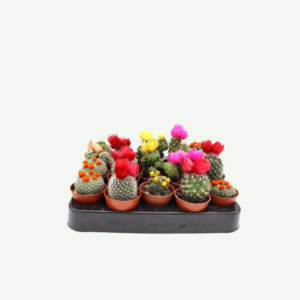Haworthia is a genus of small, slow-growing succulent plants from the Asphodelaceae family. Native to Southern Africa, these plants are highly valued for their attractive rosette shape, variety of forms, and ease of care. Haworthias are popular choices for indoor gardening, and they also make delightful additions to rock gardens and succulent arrangements.
Care of Haworthia:
Light : These plants prefer bright, indirect light. They can tolerate some direct sunlight, especially if acclimated gradually, but excessive sun exposure can lead to leaf burn. Place them near a sunny window with filtered light for best results.
Temperature : These plants thrive in average room temperatures between 65°F to 80°F (18°C to 27°C). They can tolerate slightly cooler temperatures, but frost or freezing temperatures should be avoided.
Watering : These plants are succulents and have the ability to store water in their leaves. Allow the soil to dry out almost completely between waterings, and then water thoroughly. During the winter months, reduce watering to prevent overwatering and root rot.
Humidity : These plants are adaptable to average indoor humidity levels, but they prefer slightly higher humidity. Regular misting or placing a humidity tray nearby can help increase humidity levels.
Soil : A well-draining and porous potting mix is essential for Haworthias. A cactus or succulent-specific mix or a blend of regular potting soil with perlite or sand for added drainage is suitable.
Fertilization : These plants are not heavy feeders. Fertilize sparingly during the active growing season (spring and summer) with a diluted, balanced liquid fertilizer.
Characteristics of Haworthia :
Rosettes: These plants plants typically form compact rosettes of fleshy, pointy, and triangular leaves. The leaves can have various textures, colors, and patterns, including smooth, spiky, variegated, or covered with white stripes or spots. Some species have transparent or window-like areas on the leaves, which allow light to reach deeper into the plant.
Size: These plants are generally small to medium-sized plants, with individual rosettes ranging from a few centimeters to a few inches in diameter. Their slow growth rate means they usually remain relatively compact, making them suitable for small spaces or indoor gardening.
Flowers: These plants plants occasionally produce small, tubular, and inconspicuous white or pinkish flowers on tall, slender stalks. The flowers are generally not the main attraction, as the plants are primarily grown for their attractive foliage.
Landscape Use of Haworthia:
Haworthias are commonly grown as indoor houseplants due to their small size and adaptability to indoor conditions.
They are well-suited for containers, rock gardens, and succulent arrangements, where their unique shapes and colors can be showcased.
Overall, Haworthias are delightful and low-maintenance succulents that make excellent choices for indoor gardening, particularly in homes and offices with bright, indirect light. Their stunning rosettes, fascinating leaf patterns, and tolerance for indoor conditions have made them popular among succulent enthusiasts and plant lovers looking to add diversity and charm to their indoor plant collections.






